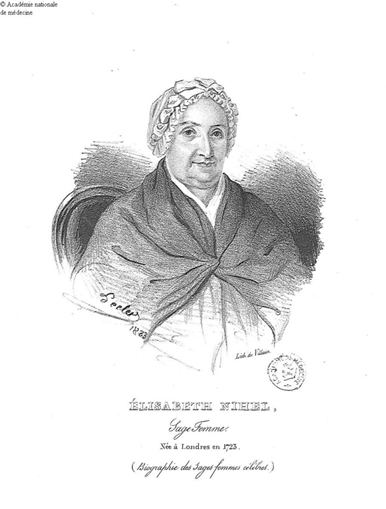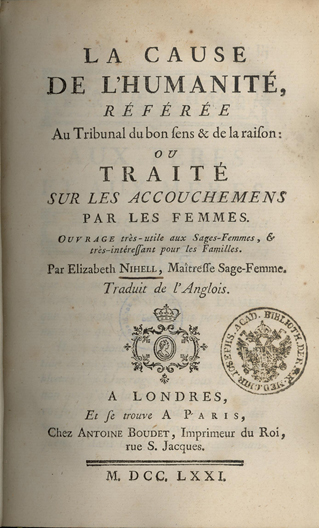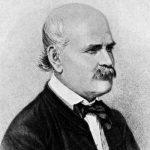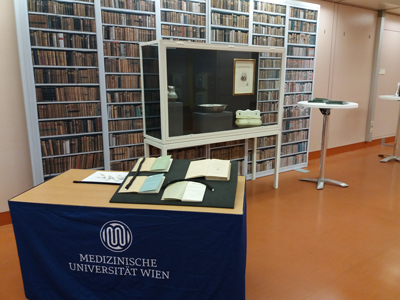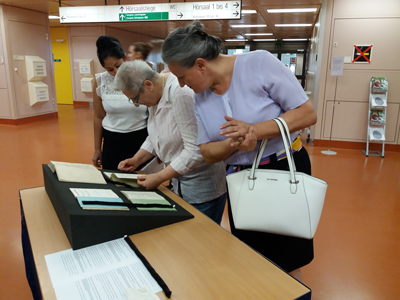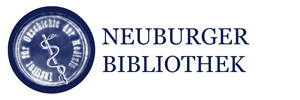Nihell, Elizabeth: La Cause De L’Humanité, Référée Au Tribunal du bon sens & de la raison: Ou Traité Sur Accouchemens Par Les Femmes. Ouvrage très-utile aux Sages-Femmes, & très-intéressant pour les Familles. Traduit de l’Anglois. London, Paris: Chez Antoine Boudet, Imprimeur du Roi 1771.
[Zweigbibliothek für Geschichte der Medizin/Josephinische Bibliothek, Sign.: JB3874]
https://ubsearch.meduniwien.ac.at/
Text: Harald Albrecht, BA
Abb. 1 Elizabeth Nihell (1723-1776)
Elizabeth Nihell (1723-1776) war eine der bekanntesten und streitbarsten englischen Hebammen ihrer Zeit. Sie wurde 1723 in England geboren und stammte aus einer französisch-katholischen Familie. 1740 zog sie nach Paris wo sie den Mediziner und Apotheker Edmund (oder Edward) Nihell heiratete. Dieser kam aus einer bekannten irischen Familie, die zahlreiche Kaufleute, Mediziner, Priester und Autoren hervorgebracht hatte. Das Paar hatte zumindest ein gemeinsames Kind. 1747 begann Elizabeth Nihell ihre Ausbildung im Pariser Hôtel-Dieu, das von Louis duc d’Orléans (1703-1752) gefördert wurde. Eine ihrer Ausbildnerinnen war die berühmte französische Hebamme Angélique Marguerite Le Boursier Du Coudray (1712-1794). Während ihrer zweijährigen Zeit im Hôtel-Dieu fanden dort etwa 2.000 Geburten statt. Nihell konnte, was für die damalige Zeit sehr ungewöhnlich war – die meisten Hebammen waren nur sehr rudimentär oder gar nicht ausgebildet – in dieser Institution einen reichen Schatz an Erfahrungen sammeln.
1754 übersiedelte Elizabeth Nihell mit ihrem Mann zurück nach London, wo sie mindestens bis 1772 als Hebamme praktizierte. Schon in Paris beobachtete sie das Aufkommen immer mehr chirurgisch ausgebildeter männlicher Geburtshelfer mit großer Skepsis und Argwohn. Die Situation in England stellte sich ähnlich dar. Während die männlichen Geburtshelfer stetig zunahmen und immer höhere Preise für ihre Dienste verlangen konnten, wurden die Hebammen immer mehr zurückgedrängt und mussten sich mit immer geringeren Honoraren zufriedengeben. Nihell versuchte sich gegen diese Marginalisierung ihrer Berufsgruppe zu wehren und attackierte ihre männliche Kollegenschaft öffentlich. „Nihell throws herself with great gusto into the very frontline of the battle between the two sexes over who should provide antenatal care and attend women in labour: female midwives with their inborn aptitude, empathetic approach and nature-friendly practice, or male practicioners keen to intervene to show their ‘superiority’ over women through crude attempts at early intervention and the use of forceps.“[1] Besonders die Geburtszangen, die ihre männlichen Kollegen verwendeten waren ihr ein Dorn im Auge, da sie ihrer Ansicht nach wesentlich mehr Schaden als Nutzen bringen würden. Eines ihrer Lieblingsziele ihrer öffentlichen Angriffe war William Smellie (1697-1793), einer der ersten und bekanntesten männlichen Geburtshelfer Englands. „Many of her strongest attacks were dedicated at William Smellie who, through his classes for both male and female midwives, had increasing influence. She belittled his physique, alluding to his large hands, ‘the delicate fist of a great-horse-godmother of a he-midwife’.“[2]
1760 publizierte Elizabeth Nihell ihr Hauptwerk unter dem Titel: Nihell, Elizabeth: A Treatise On The Art Of Midwifery. Setting Forth Various Abuses therein, Especially as so the Practice with Instruments: The Whole Serving to put all Rational Inquirers in a fair Way of very safely forming their own Judgment upon the Question; Which it is best to employ, In Cases of Pregnancy an Lying-In, A Man-Midwife; Or A Midwife. London: Printed for A. Morley, at Gay’s-Head, near Beaufort Buildings, in the Strand 1760.
Die Zweigbibliothek für Geschichte der Medizin besitzt eine französische Übersetzung dieses Buches aus dem Jahr 1771: Nihell: La Cause De L’Humanité […]. London, Paris: 1771. Nihells Werk versteht sich nicht nur als Lehrbuch für Hebammen sondern auch als Streitschrift für ihre Sache, in der sie auch für ihre Positionen eintrat.
Abb. 2 Titelblatt: Nihell: La Cause De L’Humanité […]. London, Paris: 1771.
Elizabeth Nihell konnte jedoch die Entwicklungen ihrer Zeit nicht aufhalten. Es kann angenommen werden, dass sie ca. 1771 von ihrem Mann verlassen worden war. Unter den fortschreitend erschwerten Bedingungen für Hebammen musste sie nun ohne jede finanzielle Unterstützung für sich selbst aufkommen. Ab 1775 blieb ihr nichts anderes übrig als in ein Armen-Arbeitshaus zu ziehen wo sie ein Jahr später, 1776, starb.
Quellen:
Beal, Jane: Elizabeth Nihell. A feisty English midwife (1723-1776). In: Midwifery today. (114) 2015. S. 56-57.
Bosanquet, Anna: Inspiration from the past (3). Elizabeth Nihell, the ‘anti-obstetric’ midwife. In: The practising midwife. (12/10) 2009. S. 46-48.
Nihell, Elizabeth (b. 1723). In: On the shoulders of giants: eponyms and names in obstetrics and gynaecology. Von Thomas F. Basket. London: RCOG Press 1996. S. 160-161.
Nihell, Elizabeth (1723-?). In: The history of obstetrics and gynaecology. Von Michael J. O’Dowd und Elliot E. Philipp. Carnforth/Lancashire: Parthenon Publishing Group 1994. S. 638-639.
[1] Bosanquet, Anna: Inspiration from the past (3). Elizabeth Nihell, the ‘anti-obstetric’ midwife. In: The practising midwife. (12/10) 2009. S. 46.
[2] Nihell, Elizabeth (b. 1723). In: On the shoulders of giants: eponyms and names in obstetrics and gynaecology. Von Thomas F. Basket. London: RCOG Press 1996. S. 161.
Alle Beiträge der VS-Blog-Serie: Aus den medizinhistorischen Beständen der Ub MedUni Wien–>


